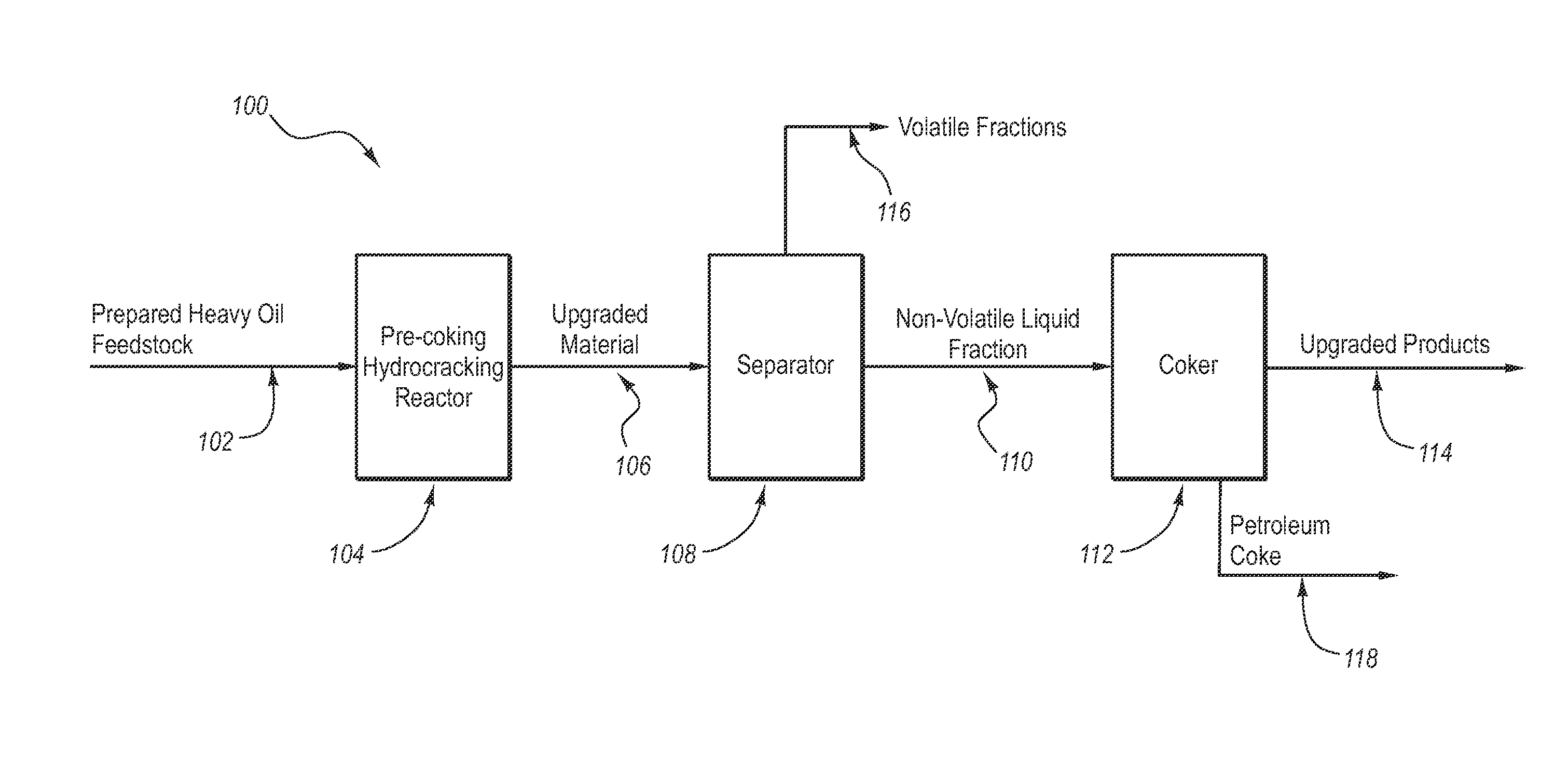Methods and systems for upgrading heavy oil using catalytic hydrocracking and thermal coking
a technology of hydrocracking and thermal coking, applied in the direction of catalyst activation/preparation, physical/chemical process catalysts, metal/metal-oxide/metal-hydroxide catalysts, etc., to achieve the effect of increasing the yield of c4+ distillate and increasing the overall conversion
- Summary
- Abstract
- Description
- Claims
- Application Information
AI Technical Summary
Benefits of technology
Problems solved by technology
Method used
Image
Examples
examples 1-5
[0136]Examples 1-5 are runs testing the hydroprocessing process as implemented by the invention using as feedstock a blend of 75 wt % Cold Lake and 25 wt % Athabasca vacuum residues. Table 1 shows the properties of the individual vacuum residues, and also of the 75 / 25 blend that was used for the test run.
TABLE 1Blended Feed forCold LakeAthabascaExamples 1 to 5VacuumVacuum(75 wt % Cold Lake / ResidResid25 wt % Athabasca)API Gravity11.7C (W %)82.982.1282.71H (W %)9.779.649.74S (W %)5.726.515.92N (W %)0.80.820.81MCR (W %)22.523.122.65Initial Boiling Point756.5657.8657.8(° F.)(by TBP Distillation)Resid Content (as wt %86.4487.0886.6of 975° F.+)(by TBP Distillation)
[0137]The results for the pre-coking hydrocracking reactions are based on a pilot hydrocracking reactor implemented according to the invention, while the coking reaction results are based on a hypothetical coking system. The pilot hydrocracking reactor system consisted of two reactor stages, each with an internal volume of 2910 ...
example 6-9
[0143]Examples 6-9 were conducted in similar fashion to the abovementioned examples, with hydrocracking tests conducted in a continuous-flow pilot unit, and coking performance predicted using the methods of the cited literature reference. For these examples, several different feedstock compositions were tested. For Example 6, Black Rock atmospheric residue was tested. Examples 7 and 8 utilized Black Rock vacuum residue. Example 9 used Murphy vacuum residue. The properties of each of these feed materials are summarized in Table 4.
TABLE 4Black RockBlack RockMurphyAtmosphericVacuumVacuumResidueResidueResidueExamples67 and 89API Gravity6.71.40.6C (W %)81.2780.3280.44H (W %)10.129.269.35S (W %)7.298.88.6N (W %)0.640.870.81MCR (W %)13.8726.5524.21Initial Boiling Point (° F.)412n / an / a(by TBP Distillation)Resid Content (as wt % of59.2495.2691.05975° F.+) (by TBP Distillation)
[0144]Test conditions for Examples 6-9 differed in several respects from those in the earlier examples. The hydrocrac...
example 10-13
[0147]Examples 10 to 13 were conducted in a fashion similar to the previous examples. In this case, all examples used a Ku 850° F.+ vacuum residue, the properties of which are shown in Table 7.
TABLE 7Ku 850° F.+VacuumResidueExamples10 to 13API Gravity3C (W %)82.31H (W %)9.64S (W %)6.11N (W %)1.02MCR (W %)25.41Initial Boiling Point (° F.)694(by D-1160 Distillation)Resid Content (as wt % of 975° F.+)82.23(by D-1160 Distillation)
[0148]For Examples 10-13, the hydrocracking pilot unit consisted of a single reactor stage of 2910 cc internal volume. Most operating conditions were maintained at constant levels for these examples, with reactor temperature at 815° F. (435° C.), pressure at 2500 psig, hydrogen feed rate at 5600 scf / bbl fresh feed, and liquid hourly space velocity at 0.35 volume fresh feed / volume reactor / hr. The only difference between these examples is the catalyst concentration, which ranged from 51 to 508 ppm by weight (as Mo), as shown in Table 8.
TABLE 8Ex. 10Ex. 11Ex. 12Ex...
PUM
| Property | Measurement | Unit |
|---|---|---|
| Temperature | aaaaa | aaaaa |
| Temperature | aaaaa | aaaaa |
| Temperature | aaaaa | aaaaa |
Abstract
Description
Claims
Application Information
 Login to View More
Login to View More - R&D
- Intellectual Property
- Life Sciences
- Materials
- Tech Scout
- Unparalleled Data Quality
- Higher Quality Content
- 60% Fewer Hallucinations
Browse by: Latest US Patents, China's latest patents, Technical Efficacy Thesaurus, Application Domain, Technology Topic, Popular Technical Reports.
© 2025 PatSnap. All rights reserved.Legal|Privacy policy|Modern Slavery Act Transparency Statement|Sitemap|About US| Contact US: help@patsnap.com



